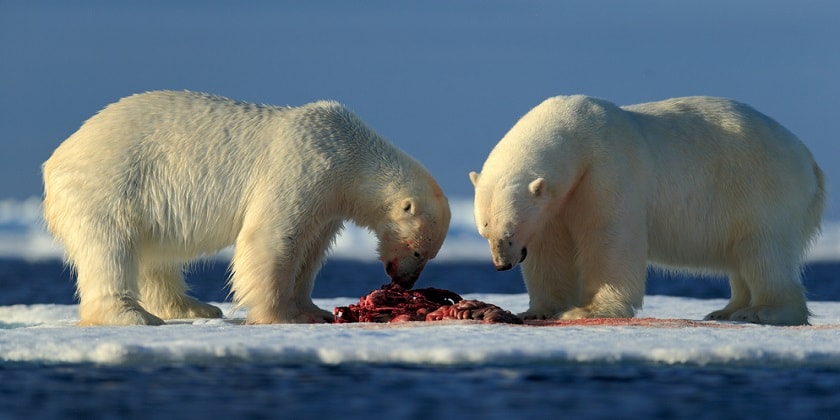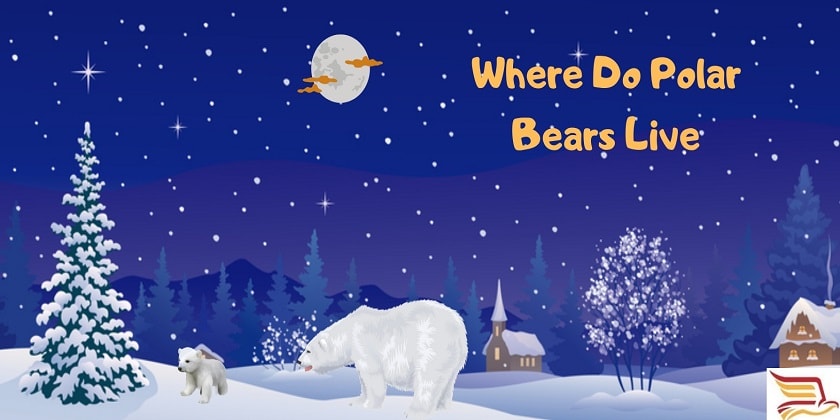You might have heard about this white ice animal of the Arctic Sea, where survival is a bit difficult for the animals, even for humans. It is absolutely a polar Bear. The polar bear is a very interesting but vulnerable species of bear that lives around the habitat of the Arctic Ocean.

In this article, we will be learning some very interesting facts about the polar bear, what polar bears eat, their habitat, diet, behavior, and many other factors that differentiate them from other bear species.
The polar bear is a species of bear that lives around the Arctic Circle. The scientific name of the polar bear is Ursus maritimus which is given by Constantine John Phipps who narrated it as a distinct species in 1774. It is the most carnivorous animal and a member of the bear family. According to the IUCN Red List, the conservation status of the polar bear is vulnerable because of the change in the climate resulting in the potential loss of sea ice.
They are marine mammals and spend most of their lives in the icy surroundings of the Arctic Sea. The giant bears are perfectly adapted to the icy and extremely freezing environment. It is the only marine mammal with powerful, large limbs and feet that allow them to travel miles on foot. Their habitat has an abundance of grasses and shrubs, so most of the diet of the polar bear consists of meat. Polar bears love to eat seals and seabirds.
Physical Characteristics of Polar Bear
The size of the polar bear is approximately similar to the size of the Alaskan brown bear (Kodiak bear). It is the largest species of bear. The weight of an adult polar bear is counted around 350 to 750 kg. According to Polar Bear International, the weight of the largest polar bear is counted around 1000 kg. The weight of the average polar bear is 450 kg, while female polar bears are half the size of males.
The weight of an adult female polar bear is recorded somewhere between 150 to 250 kg. A female polar bear can be around 450 to 500 kg in weight if pregnant. The height is measured between 3.5 to 5 ft on four legs. When the polar bear stands on its hind legs, the height of this giant animal can reach up to 9 to 11 ft. From here you can get an idea of how big this carnivore is and if you have to face it, there is no way out.
Taxonomic Classification Of Polar Bears:
| Kingdom | Animalia |
| Subkingdom | Bilateria |
| Infrakingdom | Deuterostomia |
| Phylum | Chordata |
| Subphylum | Vertebrata |
| Infraphylum | Gnathostomata |
| Superclass | Tetrapoda |
| Class | Mammalia |
| Subclass | Theria |
| Infraclass | Eutheria |
| Order | Carnivora |
| Suborder | Caniformia |
| Family | Ursidae |
| Genus | Ursus |
| Species | Ursus maritimus |
Lifespan And Appearance
The lifespan of the polar bear is 20 to 30 years but a polar bear lives for an average of 18 years. The oldest polar bear lived in the Arctic for 32 years. A very interesting fact about the polar bear is, that the hair usually seems white, but they have transparent hair.
According to the Animal Diversity Web, the skin of the polar bear is black and the fur is clear, white appearance is the result of light being refracted from the clear hair strands. It appears yellowish in the summer due to oxidation. Sometimes it may appear brown or grey.
The polar bear has an elongated body build and a longer skull and nose. They have stocky legs and small ears and tails. The feet are large and help to distribute the body weight while walking on a thick snow layer. The forepaws are much broader and provide support in swimming by giving propulsion. A polar bear has 42 teeth, the canine teeth are sharp, long, and pointy, while the cheek teeth are relatively smaller.
What Do Polar Bears Eat?
The polar bear is carnivorous, so most of its diet is made up of meat. Their diet is high in fat but low in protein. The polar bear loves to eat seals. They rely on the fatty meat of seals and other available food around them. Polar bears eat small mammals, fish, seals, walruses, whales, sea birds, and their eggs. They spent 50 percent of their time hunting and searching for food.

Sometimes they also feed on vegetation and barriers if available. The polar bear does not eat while hibernating. Ice is the platform for polar bears to hunt but in summer and early fall, the sea ice loses. They spend less time on the ice which makes them skinny and unhealthy.
How Much Can A Polar Bear Eat?
A polar bear needs an average of 2 kg of fat per day. A polar bear can eat a maximum of around 20 percent of its body weight. In one sitting, a polar bear can consume 100 pounds of meat, which is enough to provide its energy for the next eight days. But they usually don’t eat that much food.
They eat this much quantity when there is a requirement for survival. In tundra, polar bears eat walrus, beluga whales, and bowhead whale carcasses primarily. The most accessible food for the polar bear is a seal, especially for younger and female bears. While the adult males also hunt larger seals. Polar bears mostly eat ringed and bearded seals. During the summer, there is less availability of seals because of the natural holes in the ice which provides the seals more escape routes.
Their diet also includes harp and hooded seals, carcasses of beluga whales, walruses, narwhals, and bowhead whales. If there is less availability of food, especially in the summer, the polar bear will eat reindeer, small rodents, seabirds, waterfowl, fish, eggs, vegetation, berries, and human garbage. They drink water rarely, they get water from the chemical reaction that breaks down fat.
Where Do Polar Bears Live?
The polar bears are found around the Arctic Ocean. Their most popular surrounding is the ice of the Arctic Ocean. The ice edge and pressure ridges wherever fractures and refreezing occur offer the simplest hunting ground. The polar bears live in Alaska, Greenland, Russia, Canada, and Norway.

These are the countries that surround the Arctic Circle. The area where polar bears live is called the “Arctic Ring of Life”. The polar bears live around the sea ice covering the water over the continental shelf and the Arctic island chain.
They love to roam the areas where water meets with ice, usually called polynyas. Polar bears prefer to live in an area where the seal is easily available. They are large carnivorous but they don’t build territories, because the ice habitat is always moving according to the seasonal changes. Their habitat and location depend upon the availability of seals and the distribution of sea ice.
The polar bears prefer to live in food-rich areas, because of their smaller home ranges, their habitat often overlaps with other bears. An adult polar bear can travel more than 1000 kilometers to find a suitable home and food. During summer bears might stay on islands or coastlines with land-fast ice, drift on ice flows, or run aground ashore where they’re forced to endure warm weather.
How Do Polar Bears Hunt?
Polar bears’ dentition reflects their diet as well as its history. The jaw and teeth have many traits typical of carnivores, however, reveal their omnivorous origins. whereas they’ll grind vegetation, are less suited to it than Ursus arctos teeth are, they need long, sharp canines and a row of incisors across the front for grasping prey.

There’s an outsized gap between the front row and therefore the molars within the rear, that square measure pointed for cutting flesh. Their claws are semicircular and sharp for catching and holding prey. When food sources are scarce, as within the Arctic, having the ability to discover food from a distance is important.
Polar bears can’t perpetually think about sight-ringed seals. They generally keep in lairs beneath the snow, therefore polar bears have an outsized neural structure (the part of the brain associated with smell) and a really keen nose. In captivity, polar bears eat dog kibble, thawed rabbits, trout and other fish, root vegetables, and lettuce as treats.
As per the Arkive, they will smell prey that’s nearly a km away and up to a meter underneath the compacted snow. Predators whose prey is dangerous develop an additional square snout, however, seals don’t seem to be dangerous. Compared to the remainder of their bodies, polar bears have long necks and snouts with little heads. In addition, an ally to being efficient for swimming, this conjointly makes it easier for them to place their heads into ice holes or seal lairs searching for prey.
Hunting Techniques Of Polar Bear
We know what polar bears eat but how do they hunt?…. Polar bears have two main hunting techniques. Primarily, Still-hunting is used to catch the prey. In this, Polar bears find a seal’s respiratory hole within the ice and wait for the seal present on the surface to form the kill. Once a bear sees a seal coming out of the water, it’ll approach stealthily to come closer to the prey, then create an effort to catch it.

One stalking technique is slouching and staying out of sight while creeping up on the seal. Another technique is to swim through any channels or cracks within the ice till it’s shut enough to catch the seal. Mistreatment of this system a bear may very well dive below the ice and surface through the respiratory hole so as the surprise the seal and eliminate its escape route. Polar bears eat seals mostly.
Feeding typically happens instantly when the kill has been dragged aloof from the water. Polar bears consume the skin and blubber initially and therefore the rest is commonly abandoned. Alternative polar bears or arctic foxes then scavenge these leftovers. When feeding, polar bears can wash by licking and removing their fur.
One myth is that polar bears eat penguins. The interesting fact is, the region where polar bears are found in the Arctic, that is the North Pole, while penguins are found around Antarctica and the Southern Hemisphere. So there is no way that a polar bear can eat penguins.
Offspring
The polar bear is a solitary animal until the time of mating season begins. The mating season starts in April and remains till June each year. Males compete with each other to mate with the females. The Males can males will go more than 100 miles to mate with a female that they have picked up the scent of.
The fight between males can be extremely aggressive and results in torn skin, broken teeth, and sometimes very serious injuries. Mating takes place on the ocean ice however the fertile eggs don’t implant till the subsequent fall, and as long as the mother has enough fat to sustain herself and her cubs throughout the long denning season.
This method is named delayed implantation. Adult males stick with the feminine for some days before commencing on their own. After the mating, the gestation period remains for eight months and a female polar bear gives birth to 1 to 4 wee cubs in an offspring. They mostly give birth to twins or two cubs, sometimes litters of 3 to 4 cubs are also possible.
Before giving birth, they dig a cave called, a maternity den from a snowbank to have their cubs. The weight of a born pub is counted between 1.3 to 1.5 pounds and the length reaches up to 12 in. Mothers nurse their cubs in a sitting position or lying down on their facet or back.
Care Of Young Polar Bears
During their initial few weeks of life, cubs are nursed most of the time and kept to their mother to stay heat. For the following 3 or four months, the cub’s nurse is usually six-fold on a daily basis. The length and variety of nursing bouts step by step decrease because the cubs get older. We know what polar bears eat when they become adults but the diet of young pups is small in pieces.

Mother polar bears nurse their cubs for as long as thirty months. Some cubs stop nursing as young as eighteen months older, however, stay with their mothers for survival till they’re thirty months old. The average fat content of a mother’s milk is thirty-third, the same as the milk fat of different marine mammals.
Polar bear cubs learn to hunt from their mother by watching them hunt. Cubs strive to look in their 1st year, however, they do not appear to achieve success till they are over one year previous. Even then, they solely pay concerning four-dimensional time looking. Baby polar bears eat blubber of the seal.
By the time they are 2 years old, they pay concerning seven-membered of their time looking and may catch a seal every 5 or six days. When her cubs square measure thirty months previous, a mother is prepared to breed once more. At now, a male might begin following her.
Knowing about the polar bear is really interesting. They are amazing marine mammals and live half of their lives in search of food. Do you know anything about polar bears?… or what do polar bears eat?……you may share the information with us. Let us know if this article is helpful and informative for you below in the comment section.

 T-Shirts
T-Shirts Long Sleeves
Long Sleeves Hoodies
Hoodies Sweatshirts
Sweatshirts

 Baby Bodysuits
Baby Bodysuits
 Cap
Cap





2022. How many polar bear are there? From 1970 to 2022, is the population increasing or decreasing or remaining the same?